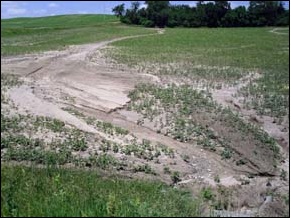|
|
University researchers have found that early planting is critical to producing high soybean yields.
Data collected from the first five years of the Michigan Soybean Yield Contest supports these findings. The average planting date for the top five producers from each of the past five years was May 4 — 13 days earlier than the average planting date for the low-yield producers.
The most important benefit from planting soybeans early is higher yields. Researchers at the University of Wisconsin found that soybean yields decrease by 0.4 of a bushel per acre per day when planting is delayed past the first week of May.
University of Nebraska research showed that yield losses of 0.25 bushels per acre occur in years with poor growing conditions and losses of 0.6 bushels per acre occur under good growing conditions each day that planting is delayed after May 1.
Research conducted by Iowa State University found that the yield benefit of planting early is greater on highly productive soils.
Dr. James Specht at the University of Nebraska has identified the following reasons for the yield increases associated with early-planted soybeans:
- Early-planted soybeans produce a larger crop canopy earlier in the growing season which leads to better utilization of the solar radiation and soil moisture available during the growing season. Sunlight striking bare soil is not only wasted, but it is detrimental as it increases soil moisture losses due to evaporation.
- Early-planted soybeans produce more nodes on the main stem increasing the potential for more pods per plant. Again, data collected from the Michigan Soybean Yield Contest supports this as the high-yield producers averaged 10 more pods per plant than the low-yield group.
Another advantage of early planting is that it provides a longer planting window for attaining maximum yields. If managed properly, soybeans planted during the last week of April can produce similar yields as those planted during the first week of May.
This is important as some of our best planting conditions in recent years have occurred in April.
Understanding The Risks
The primary risk of early-planting is emerged soybean plants will be damaged by freezing temperatures as the growing point is exposed and vulnerable when the cotyledons emerge from the soil.
This risk is mitigated to some degree by the fact that germination and emergence may take up to 14 days in cool soil. Soybean seedlings in the VE to VC growth stages can tolerate temperatures around 29 to 30 degrees F for short periods of time.
If the seedlings have hardened off through exposure to cool temperatures for several days, they can tolerate temperatures as low as 28 degrees F. Once the trifoliate leaves emerge, low temperature tolerance is reduced and temperatures below 32 degrees F will cause damage.
Another risk to consider when planting early is poor germination and emergence. As mentioned earlier, soybeans take longer to emerge in cool soils. The longer they are in the ground, the greater the exposure to soil-borne diseases such as pythium and insect feeding.
If the seed was planted into extremely cold soils or a cold rain occurs right after planting, there is also the risk of imbibitional chilling injury. Researchers in Ontario demonstrated that soybean seed is the most vulnerable to injury from cold soil temperatures during the first six to 24 hours after planting.
Early-planted soybeans that emerge uniformly and escape frost or freeze injury also have a higher probability of experiencing damage from bean leaf beetles and sudden death syndrome (SDS) than soybeans planted later in the season.
Recommendations
If you decide to plant soybeans in April, consider the following recommendations:
- Don’t plant unless the soil is dry enough to support equipment and allow planting equipment to operate properly. Shallow soil compaction and sidewall compaction will haunt you the remainder of the growing season.
- Treat the seed with Apron or Allegience fungicides to protect the seedlings from the soil-borne pathogen pythium.
- To reduce the potential for frost or freeze injury to emerged seedlings, plant in fields at higher elevations having good air drainage and till the field or clear the residue away from the row.
- Plant only the highest quality seed as overly dry seed or seed having damaged seed coats will take in soil moisture more rapidly, increasing the likelihood for imbibitional chilling injury to occur.
- If possible, plant when the soil temperatures are expected to be above 50°F for the first six to 24 hours following planting. If you must plant into cold soils, wait until noon to begin planting to allow the soil to warm.
- Consider planting slightly shallower if soil moisture is available and planting equipment is providing uniform depth control and good seed-to-soil contact. This allows the seed to be placed into slightly warmer soil and also compensates for the fact that cold soils reduce hypocotyl elongation. Never plant less than 3/4 of an inch deep.
- Consider increasing seeding rates by up to 10 percent when planting early.
- Reduce the potential for sudden death syndrome by planting into well-drained soils that are free from compaction and using SDS tolerant varieties.
- Consider planting seed treated with an insecticide registered for bean leaf beetle if damage is expected.

 Erosion occurring in a late-planted soybean field. (MSU photo).
Erosion occurring in a late-planted soybean field. (MSU photo).




Post a comment
Report Abusive Comment